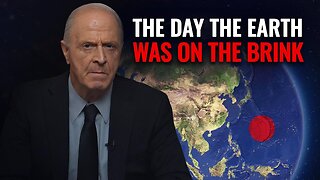Premium Only Content

Asia NOW! Typhoon Yagi Ravages the Philippines, China, and Vietnam. Devastation Unfolds
Typhoon Yagi is the strongest tropical cyclone to hit Asia this year. It caused significant damage to the Philippines, several Chinese provinces, and northern Vietnam, resulting in the deaths of dozens of people, with many still missing, and hundreds injured.
Known in the Philippines as Enteng, Typhoon Yagi formed on September 1 off the eastern coast of the Philippines, quickly gained strength, and reached the island of Luzon. It brought heavy rains across the country, with up to 16 inches of rainfall in some areas. Landslides and widespread flooding forced over 47,600 people to leave their homes.
In the Philippines, 20 people lost their lives due to the disaster, several more went missing, and over two million people were affected.
On the evening of September 5, the typhoon passed about 250 miles from Hong Kong, bringing heavy rainfall. Precautions were taken in the region: schools were closed, and the Hong Kong Stock Exchange was suspended.
The next day, September 6, Yagi, now a super typhoon, made landfall near Wenchang City, Hainan Province, at approximately 4:20 PM local time and again in Xuwen County, Guangdong Province, around 10:00 PM local time. According to the Central Meteorological Observatory, Typhoon No. 11 became the strongest autumn typhoon to hit China since 1949. Notably, Yagi remained at super typhoon status for 64 hours.
Additionally, the radius of its outer circulation was very large, directly contributing to the typhoon's destructive impact. On the eastern side, rain bands hit the Pearl River Delta, eastern Guangdong Province, and even the coastal areas of Fujian Province, causing heavy and, in some places, extreme rainfall. In the northwest, typhoon-induced winds reached Sichuan and Chongqing, triggering thunderstorms there.
The damage caused by the super typhoon is hard to describe. Words cannot capture the scale and power of the storm. Countless trees were uprooted, and streets were in total chaos. The strong winds shattered windows of some residential and office buildings. Witnesses recalled, “The windows kept vibrating, and the building swayed from time to time.”
In Xuwen County, Guangdong Province, the typhoon destroyed the entire second floor of a store, leaving only a few steel columns. On the streets, powerful winds overturned an 18-ton truck.
As of September 7, the natural disaster had affected 1.227 million people in Hainan, Guangdong, and Guangxi provinces to varying degrees, resulting in 4 deaths and 95 injuries.
Typhoon Yagi made landfall in northern Vietnam on September 7 during the day. According to the country's Central Center for Hydrological and Meteorological Forecasting, it hit the provinces of Haiphong and Quang Ninh with wind speeds of 93 miles per hour.
Operations at four airports, including Noi Bai International Airport in Hanoi, were suspended, and over 300 flights were canceled. Secondary schools in 12 northern provinces of Vietnam were closed, and Hanoi suspended urban transportation and two elevated metro lines.
As a result of the typhoon, 25 ships sank, more than 7,300 houses were damaged, and hundreds of power line poles were knocked down. Tens of thousands of trees fell, broke, or were uprooted... However, these are only preliminary estimates after more than a day of Typhoon Yagi raging.
According to the National Center for Hydrometeorological Forecasting, this is the fastest-intensifying storm in Vietnam's meteorological history. As of September 8, Typhoon Yagi had caused the deaths of 21 people in Vietnam, with 3 missing and at least 229 injured.
More frequently in expert assessments of climate disasters, we hear phrases like “for the first time in recorded history,” “strongest,” and “record-breaking.” This trend should make thoughtful and observant people reflect on the fact that we are now witnessing events that have never happened before. For those interested in understanding these changes, we recommend watching the forum "Global Crisis. The Responsibility." There, you will learn scientists' predictions about the future climate of our planet and what we can do now to protect ourselves and our loved ones from the approaching climate chaos.
-
 42:28
42:28
AllatRa TV
14 days agoThe Day the Earth Was on the Brink
188 -
 1:03:25
1:03:25
Kyle Fortch
4 hours ago $1.70 earnedRick Barker: Managing & Developing Taylor Swift, Breaking Artists Today & MORE | THE ONE SHEET S1E5
15.1K -
 37:11
37:11
BonginoReport
6 hours agoDan Bongino is Leaving (Ep.146) - 02/24/2025
225K378 -
 2:59:20
2:59:20
Wendy Bell Radio
7 hours agoThe MAGA Diet
165K55 -
 1:22:03
1:22:03
Graham Allen
5 hours agoGRAHAM MAKES YUGE ANNOUNCEMENT!! + LIBERAL REP ROOTING AGAINST AMERICA?!
76.1K90 -
 1:01:28
1:01:28
Randi Hipper
3 hours agoETHEREUM PRICE BOUNCES AFTER BILLION DOLLAR HACK!
33.4K1 -
![Massive Paradigm Shift: Bongino Hired At FBI; Joy Reid Fired At MSBNC [EP 4450-8AM]](https://1a-1791.com/video/fwe1/52/s8/1/u/2/_/e/u2_ey.0kob-small-Massive-Paradigm-Shift-Bong.jpg) DVR
DVR
The Pete Santilli Show
17 hours agoMassive Paradigm Shift: Bongino Hired At FBI; Joy Reid Fired At MSBNC [EP 4450-8AM]
58.4K18 -
 1:27:17
1:27:17
Game On!
16 hours ago $2.71 earnedAnother Monday without football...
94.9K9 -
 1:43:56
1:43:56
Jeff Ahern
4 hours ago $2.60 earnedMonday Madness with Jeff Ahern (Ding Dong the Witch is Gone!)
74.7K3 -
 34:56
34:56
Athlete & Artist Show
1 day ago $2.10 earnedCANADA WINS GOLD AGAIN!!
25.8K2